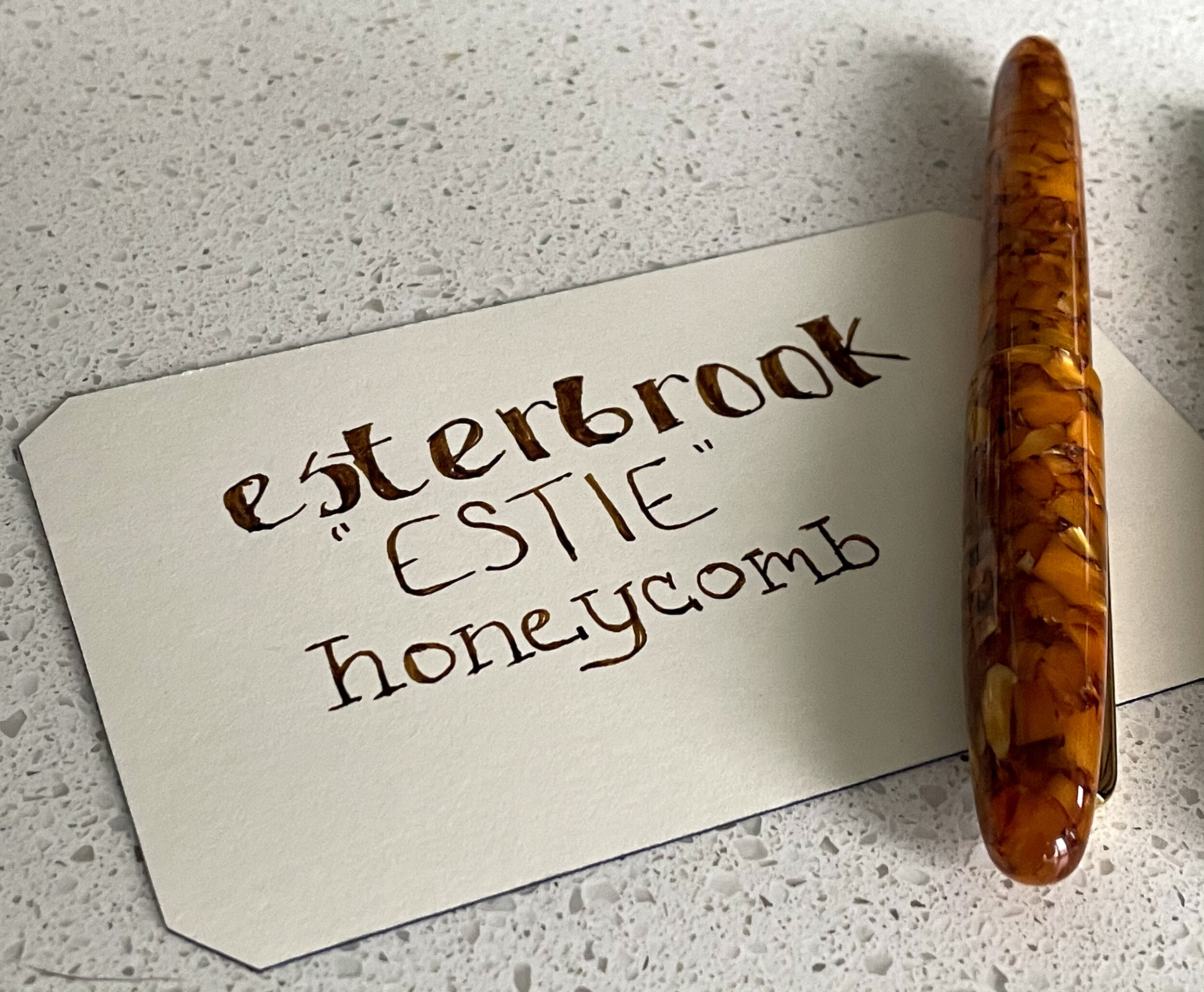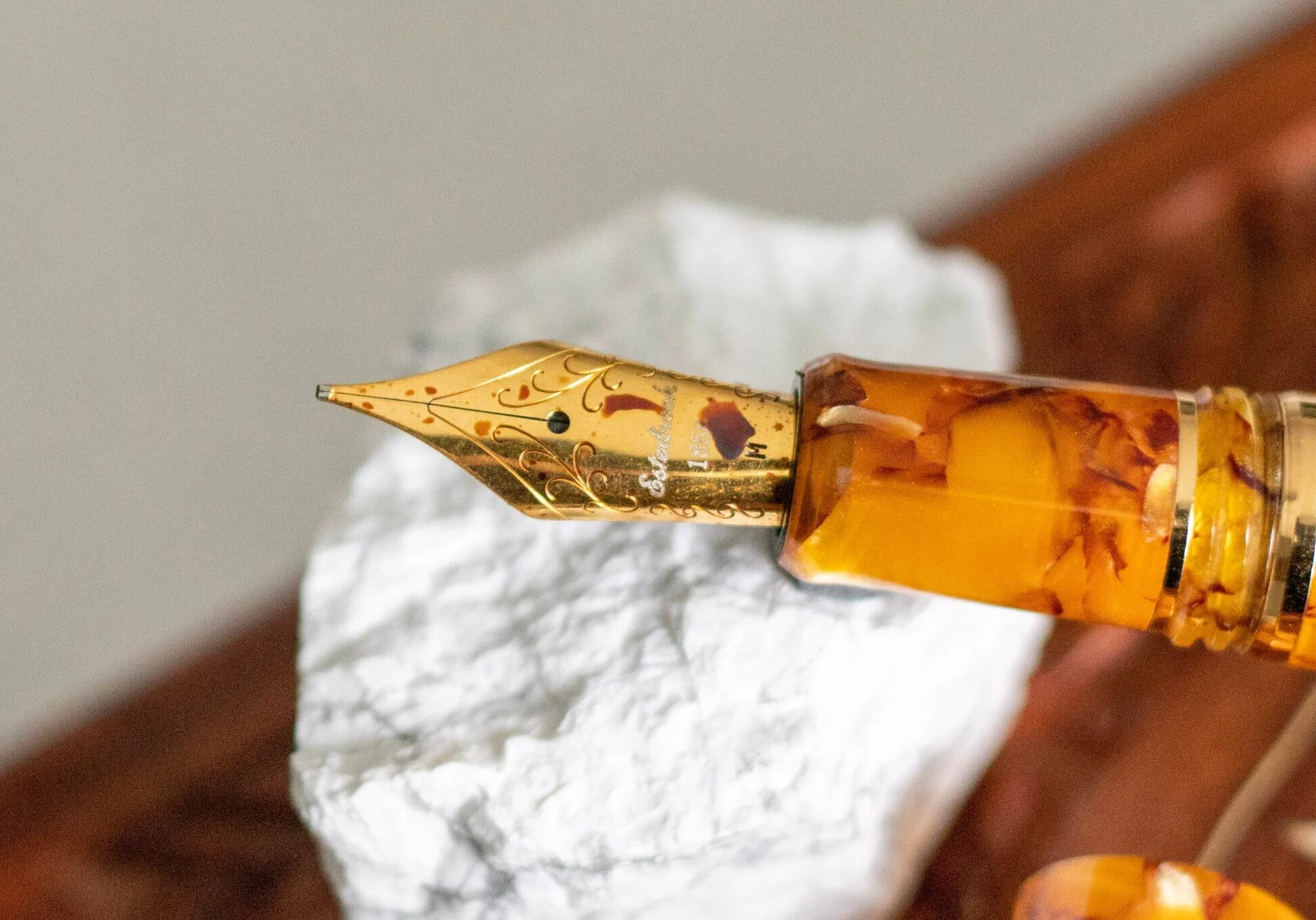Esterbrook Estie Honeycomb
An American Heritage
Esterbrook is on fire right now in the fountain pen world, and it’s not hard to see why. They’ve got a whole new rebranded campaign and they’ve partnered with nibmeister Gena Salorino (Custom Nib Studio) for a special “journaler” nib grind that’s only available through them (or, ostensibly, through a special grind request to Gena directly).
But let’s back up a moment and take a look at the history of the brand.
The Esterbrook Pen Company was founded in 1858 by English immigrant Richard Esterbrook with manufacturing based in Camden, New Jersey. The company started small but growth was steady and eventually Esterbrook became the largest pen manufacturer in the United States, producing 216,000,000 pens a year.
The Esterbrook Pen Company enjoyed many successes and changes for over 100 years. However, the 1960’s saw a decline for the company, and the Esterbrook Empire was sold in 1967 to the Venus Pencil Company, and then finally ceased all operations in 1971.
In 2014, Harpen Brand Holdings, LLC acquired the rights to the “Esterbrook” brand name and attempted a revival. This attempt, however, fell quite short of expectations for many.
Luckily for us, this isn’t where their story ends. In 2018, Kenro Industries acquired the brand and has been enjoying a successful comeback with pens like the entirely new Esterbrook “Estie” and a throwback homage with the Esterbrook JR Pocket Pen (the “J” being a reference to the old Esterbrook J, Esterbrook’s original classic pocket pen and the R standing for “reborn”).
If you’re anything like me, you like a good story to go with your pen. Esterbrook’s claim to fame in this regard is that many US Presidents - Abraham Lincoln, John F. Kennedy, and Lyndon B. Johnson - signed legislation with their Esterbrook pens. In fact, according to this blog, “in 1964, the Civil Rights Act was signed by Lyndon B Johnson using 72 clear Lucite Esterbrook Fountain Pens, these were then gifted to attending dignitaries and supporters of the bill including; Robert F Kennedy (Attorney General at the time), Everett McKinley Dirksen, Hubert Humphrey, Rosa Parks and Martin Luther King Jr.” Personally I find this absolutely fascinating and awesome.
Disney artist Carl Banks used an Esterbrook No 356 to bring us Donald Duck. If you’ve ever identified with the character Charlie Brown (or maybe you’re more of a Lucy O_O), you can thank the Esterbrook No 914 that Charles M. Schulz used for all of his comics.
From the Esterbook website:
Esterbrook grew up in the shadows of one of the nation’s darkest hours, but despite the toll of the Great Depression on the United States, there was an enduring spirit of its people, a new hope awakening, importance placed on the strength of character and a deep enthusiasm for achieving dreams. Esterbrook met those values with writing instruments that were emblematic of those times and commitments.
Today we champion those same tenants, facing the future with the determination and tenacity of those before us.
Accordingly, Esterbrook stands for what it always has: entrepreneurial spirit, outstanding quality at a great value, and creative designs that made the original Esterbrook brand an American icon and global player. Joel Blumberg, Kenro’s founder and president, acquired the rights and patents for this original American brand for these very reasons. Says Blumberg: “If you take the time to dig into Esterbrook’s heritage and how much this brand and its pens were part of great American history and cultural development, you start to see all those parallels to today and why a brand like Esterbrook still has its place in our digital world. That’s why we plan to reintroduce and build the Esterbrook brand on the same values as it was originally born. Times are different, but core values remain deep in our DNA and this is what we are building on with this brand relaunch”. Blumberg adds: “We decided to relaunch this iconic brand with what we call the re-concept. “Re” means to do simultaneously looking back to the original state. This is exactly what the essence of the Esterbrook relaunch is”.
The timing couldn’t be better for Esterbrook to tap into the increasing demand by long-time collectors and a growing demographic of new pen enthusiasts for well- made, old fashioned, quality items with history and authentic stories.
To that end, Kenro has written a Manifesto for this incarnation of the Esterbrook Brand:
We want to reconnect with consumers, rebuild interest in fine writing and penmanship, revolt against the decline of handwriting in American schools, reestablish brand image as an American Original, regain trust and market share with retail partners, and revive the values and spirit of Richard Esterbrook for the 21st century.
It’s a pledge to our admirers and enthusiasts: as they persist, so do we.
Esterbrook endures.
The “Estie” style of pen (a classic cigar shape, very reminiscent of vintage pens) comes in quite a few different colors schemes. The one that I ended up going with was the “Honeycomb” which is the one pictured above and throughout this blog post, but I’ve considered the “Blueberry” and the “Evergreen”, both with the sort of “cracked” look, if you will. The newest Estie is more of a swirled look and comes in “Rocky Top” and “Peacock.” I’m a big fan of the Rocky Top, personally.
Also, most of the Esties come with the option to choose between silver and gold “hardware” - aka the color of the nib, the clip, and the bands. I tend to prefer gold over silver, and I liked the warmth it brought specifically to the Honeycomb coloring.
It also comes in two sizes - “regular” and “oversized.” Some color variations even come in a “slim” size, which is smaller than the regular. The one I got is “regular” sized.



You can see from the above pictures that it’s larger both capped and uncapped than the Lamy 2000 and the Sailor Pro Gear Slim.
When I first opened it, I was surprised at how big it seemed, and worried that I wouldn’t care for it. However, I enjoy using it unposted and it hasn’t hindered my experience at all. The body is made from resin, so it’s sturdy but lightweight overall.
The Estie fills via a cartridge/convertor system, and comes with a convertor.
The Estie is fitted with a #6 JOWO German Steel nib - a respected and consistently great producer of nibs, and I opted for the special “Journaler” nib that was custom ground by Gena Salorino. It was a $50 upgrade fee, but this was my first foray into custom ground nibs and I figured this was the easiest way to start!
Per Gena herself, she describes the “Journaler” nib as such:
The custom nib I’m grinding for Esterbrook is called the Journaler. It’s a medium stub grind, based on the vintage Esterbrook 9314M nib. The idea is that it’s smooth and friendly enough for everyday use, gives your writing some flair, all without being too huge for practical writing.
The Journaler was smooth from the start and is definitely a good intro nib for someone who hasn’t used a custom grind before. I highly recommend it.
But, you can also get the pen with an EF, F, M, and B nib if in stock.
You can see the flatter tipping creating the “stub” effect when writing.
Writing sample between the Estie Journaler nib (inked with KWZ Honey) and the Sailor PGS in MF (inked with Monteverde California Teal)- you can see that the line width on the vertical strokes with the journaler are much wider than the horizontal strokes, creating a bit of dimension with the writing. (Fun fact - the architect nib is a stub in reverse, review coming soon with some pens and architect nibs!)
A really neat thing about the Estie’s design is that the company also developed a “nib adaptor” so that you can fit the pen with original Esterbrook nibs. You do need to buy this separately, but if you are into the feel of the old nibs (which are quite different) or you have some laying around that you want to use with the new pen, then you can easily do this with the adaptor!
A downside to the adaptor is that it is black, so if you use it, the nib section of your pen that twists into the main body will be black instead of matching the pen you have.
Final Impressions
I genuinely love this pen. It feels great in the hand, it writes great, but most of all, I love the way it looks. I love the slightly shimmery essence of the material that makes it seem very ethereal - as if the warmth and light is coming from inside the pen itself.
While I wouldn’t call the looks of the pen “loud” it does stand out a bit, so be prepared to get some questions or looks if you’re using it in public/work spaces that don’t normally see more unusual pens.
The price range for the Estie comes in around $156-$280, depending on the size and model you get. I do think that this is a bit high for a resin pen with a steel nib, as you can get pens with golds nibs for less, but the beauty of the Estie is hard to resist. I would like another Estie, but due to the price I don’t see myself getting another one unless I find a spectacular deal on it.
Middle Earth Rating - To Beorn or not to Beorn
My first thought for this pen was actually to put it under the category of hobbit but then I remembered this passage from The Hobbit, Ch 7, in which we meet Beorn, the skin-changer:
There was a buzzing and a whirring and a droning in the air. Bees were busy everywhere. And such bees! Bilbo had never seen anything like them. […]
They were bigger than hornets. The drones were bigger than your thumb, a good deal, and the bands of yellow on their deep black bodies shone like fiery gold.
“We are getting near,” said Gandalf. “We are on the edge of his bee-pastures.”
If you’ll remember, Beorn could turn into (at the very least) a bear, and Bilbo and the dwarves took refuge in his hall during their journey to The Lonely Mountain. Beorn had a special relationship with animals, and he was basically like a hippie farmer (vegetarian, grew all his own stuff, self-sustaining).
Picturing his bee-pastures, I am imagining inspiration for the Estie Honeycomb look - a bit magical, a bit practical. But then I realized that Beorn is very unlikely to use writing instruments. He is a loner and has other ways of communicating should he need to get a message out.
So, in the end, I’m going to go with hobbits on this pen, because I can imagine Bilbo coming back to the Shire and describing Beorn’s home to someone and them being inspired enough to create a writing instrument from Bilbo’s stories. Plus, hobbits are farmers too and very likely have their own bee-pastures, albeit much less magical.
The multi-dimensional warm browns of this pen would definitely look at home in a comfy, cozy hobbit hole serving as a constant reminder of the earth that they live in and the honey that they drink in their tea during their many (many) tea times.




